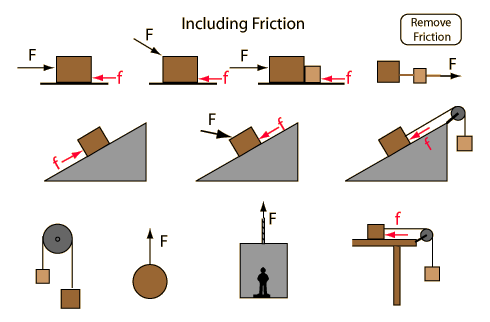Newton's three laws of motion:
1. Inertia --> objects will continue to be stationary or in motion unless an external force is affecting it
2. F = ma --> force is directly related to acceleration and thus mass is indirectly related to acceleration
3. For every force, there is an equal force going in the opposite direction.
Thus, there are four applications from Newton's laws. They are equilibrium, inclines, pulleys, and trains.
Equilibrium
- occurs when the object is not moving at all
Assumptions:
- no friction
- a = 0 (and therefore ax and ay are also 0)
Inclines
Static:
- occurs when the object is not moving while it is on a slanted base
Assumptions:
- no acceleration
- positive axes in the direction of motion
- no air resistance
- μ = tanΘ
- static friction = coefficient of static friction times normal force
Kinetic:
- occurs when the object is sliding down a slope
Assumptions:
- positive axes in direction of motion
- normal force is perpendicular to surface
- no air resistance
- ax ≠ 0, ay = 0
- kinetic friction = coefficient of kinetic friction times normal force
Pulleys
- occurs when objects are at a distance from each other separated by a wheel held by ropes
Assumptions:
- frictionless pulleys + rope
- no air resistance
- multiple free body diagrams
- positive axes in direction of motion
- T1 = T2
- acceleration of system is the same
Trains
- occurs when one uses common sense to figure out what a train is
Assumptions:
- 1 FBD for acceleration
- 3 FBDs for T1 & T2
- ay = 0
- a is consistent
- no air resistance
- weightless cables
- positive axes in direction of motion
All four applications may be used to figure out the calculations for tension, force, mass, and acceleration.

No comments:
Post a Comment